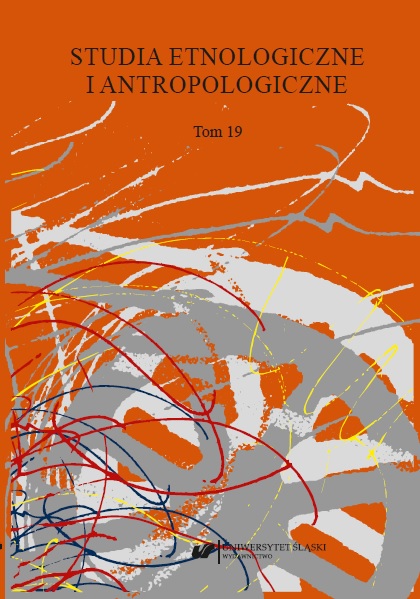"Folk Design” Aneta Larysa Knap. NaLudowo.pl. https://naludowo.pl/folk-motywy/moda-na-ludowo/aneta-larysa-knap-folk-design-moda-na-ludowo-nowy-targ-etno-podhale-jeansy-z-parzenica-kierpce-na-obcasie.html [data dostępu: 27.01.2019].
Google Scholar
AGA POU. Zaplątani. https://agapou.com/zaplatani/ [data dostępu: 25.01.2019].
Google Scholar
Barański J.: Świat rzeczy. Zarys antropologiczny. Kraków 2007.
Google Scholar
Bazielich B.: Kolory Europy. Odzież i stroje ludowe. Katowice 2008.
Google Scholar
Bazielich B.: Z bliska i z oddali. Stroje ludowe na Śląsku. Katowice 2017.
Google Scholar
Benjamin W.: Twórca jako wytwórca. Poznań 1975.
Google Scholar
Brzezińska A.W.: Strój ludowy – od biografii przedmiotu do tożsamości podmiotu. W: Stroje ludowe jako fenomen kultury. Red. A.W. Brzezińska, M. Tymochowicz. Wrocław 2013 (Atlas Polskich Strojów Ludowych. Zeszyt specjalny), s. 15–24.
Google Scholar
Brzezińska A.W., Słomska-Nowak J.: Czy i jak badać strój ludowy? W: Etnologiczne i antropologiczne obrazy świata – konteksty i interpretacje. Red. H. Rusek, A. Pieńczak. Cieszyn 2011, s. 62–74.
Google Scholar
Burszta W.J.: Od mowy magicznej do szumów popkultury. Warszawa 2009.
Google Scholar
Burszta W.J.: Świat jako więzienie kultury. Kraków 2008.
Google Scholar
Chrost D.: Moda w kolorach Śląska. Nowiny Zabrzańskie. nowinyzabrzanskie.pl/gospodarka/moda-kolorach-slaska-galeria/ [data dostępu: 30.01.2019].
Google Scholar
Comaroff J.L.: Etniczność sp. z o.o. Przeł. W. Usakiewicz. Kraków 2011.
Google Scholar
Czerwińska K.: Strój jako wyzwanie artystyczne. W: Eadem: Przepakować dziedzictwo. Przeszłość jako projekcja rzeczywistości – przypadki śląskie. Katowice 2018, s. 126–132.
Google Scholar
Daglová O.: Dekor symbol. Dekoratívna tradícia na Slovensku a európsky kontext. Bratislava 2001, s. 240–254.
Google Scholar
Etnoinspiracje. Inspiracje kulturą ludową we współczesnym polskim wzornictwie, modzie, architekturze, reklamie… Red. K. Kulikowska, C. Olbracht-Prondzyńska. Gdańsk 2012.
Google Scholar
Fišerová-Kvěchová H.: Lidové umění jako inspirační zdroj v díle Marie Fischerové-Kvěchové. „Studia Ethnologica Pragensia” 2016, číslo 1, s. 41–50.
Google Scholar
Folk Deisgn. https://facebook.com/folkdesignanetalarysaknap/ [data dostępu: 30.01.2019].
Google Scholar
Folk Design. https://folkdesign.art-madam.pl/ubrania [data dostępu: 25.01.2019].
Google Scholar
Frejlich C.: Ergonomia i wzornictwo. W: O!to design. Spotkanie z polskim designem / A Meeting with Polish Design. Łódź 2010, s. 48–49.
Google Scholar
Ingarden R.: Studia z estetyki. T. 3. Warszawa 1975.
Google Scholar
Kopytoff I.: Kulturowa biografia rzeczy – utowarowienie jako proces. W: Badanie kultury. Elementy teorii antropologicznej. Wybór i przedm. M. Kempny, M. Nowicka. Warszawa 2003, s. 249–274.
Google Scholar
Korduba P.: Ludowość na sprzedaż. Warszawa 2013.
Google Scholar
Langhammerová J.: České tradice v proměnách času. Kroje – zvyky – umění. Praha 2017.
Google Scholar
Mathews G.: Supermarket kultury. Kultura globalna a tożsamość jednostki. Przeł. E. Klekot. Warszawa 2000.
Google Scholar
Piskorz-Branekova E.: Czy strój noszony w okolicach Hrubieszowa i Tomaszowa Lubelskiego możemy nazwać hrubieszowsko-tomaszowskim? Problem z terminologią. W: Stroje ludowe jako fenomen kultury. Red. A.W. Brzezińska, M. Tymochowicz. Wrocław 2013 (Atlas Polskich Strojów Ludowych. Zeszyt specjalny), s. 151–160.
Google Scholar
Piskorz-Branekova E.: Polskie stroje ludowe. Warszawa 2008.
Google Scholar
Piskorz-Branekova E.: Tradycyjne stroje i hafty hrubieszowskie i tomaszowskie. Zamość 2011.
Google Scholar
Šotková B.: Naše lidové kroje, jejich vzory, střihy a zpracování. Praha 1952
Google Scholar
Sulima R.: Supermarket – przyczynek do retoryki konsumpcji. W: Idem: Antropologia codzienności. Kraków 2002.
Google Scholar
Tataj D.: Od awangardy do innowacji. W: W kręgu sztuki przedmiotu. Red. M. Dłutek. Warszawa 2011, s. 38–48.
Google Scholar
Tradycja w nowoczesnym wydaniu. „Górnoślązak. Gazeta Związku Górnośląskiego” 2016, nr 10 (17), s. 2. zg.org.pl/gazeta/gornoslazak-2016-nr-10-17 [data dostępu: 26.01.2019].
Google Scholar
Tradycja wynaleziona. Red. E. Hobsbawn, T. Ranger. Przeł. M. Godyń, F. Godyń. Kraków 2008.
Google Scholar
Trebunia-Staszel S.: Podhalańskie elegantki i miejscowi kreatorzy mody. W: Stroje ludowe jako fenomen kultury. Red. A.W. Brzezińska, M. Tymochowicz. Wrocław 2013 (Atlas Polskich Strojów Ludowych. Zeszyt specjalny), s. 119–130.
Google Scholar
Współczesna problematyka badań nad strojem ludowym. Red. A.W. Brzezińska, M. Tymochowicz, A. Paprot-Wielopolska. Wrocław 2018 (Atlas Polskich Strojów Ludowych. Zeszyt specjalny).
Google Scholar


 https://doi.org/10.31261/SEIA.2019.19.05
https://doi.org/10.31261/SEIA.2019.19.05

 10.31261/SEIA
10.31261/SEIA